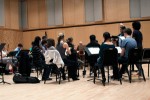Title
On April 29, 214 years to the day after Haydn’s The Creation was premiered, in Vienna, a large gathering of Juilliard and Yale musicians will perform the beloved oratorio in New Haven at Woolsey Hall, to be reprised in New York the next day at St. Bartholomew’s Church. This is the second collaboration between Juilliard and the Yale Schola Cantorum, building on the great success of last year’s St. Matthew Passion. Masaaki Suzuki will conduct the collective for the second year and Riccardo Minasi will be the concertmaster.
Body
This will be first public performance in which the musicians of Juilliard415, the Historical Performance program’s student ensemble, use instruments of the late 18th century and that are tuned to A=430 Hz (approximately a quarter tone lower than modern pitch, and a quarter tone higher than is usual for Baroque music). These performances also represent a significant expansion of the program’s focus. While music up to the death of Schubert has been Historical Performance’s stated purview since it started, three years ago, the high Baroque has dominated the largest projects to date, with some excursions backward into the 17th century.
The Creation has occasioned a string of events focused on Classical repertoire, designed in part to prepare the students—and ready the equipment—for this enormous undertaking. In the fall, the renowned Ton Koopman of the Amsterdam Baroque Orchestra led a performance of C.P.E. Bach and Haydn symphonies, but on Baroque instruments tuned at A=415 Hz. In February, Juilliard415 presented Mozart and Haydn symphonies at a workshop performance with Richard Egarr, showcasing the fruits of some brief but intensive work on Classical style and instruments. In January and February, students received coachings on chamber music of Mozart, Haydn, Kuhlau, and Danzi from the London Haydn Quartet, clarinetist Eric Hoeprich, and fortepianist Malcolm Bilson, as well as from members of the Juilliard faculty. And at press time, clarinet professor Charles Neidich was readying modern clarinet students to play Classical clarinet, six new late-18th-century-model bows had been added to the school’s collection, and two fortepianos had been rented for the performances.
Perhaps most significantly, the woodwind players of the Historical Performance program have added another instrument to their already diversified portfolios. While a few already had significant experience on Classical equipment—traverso flute player Antonio Campillo Santos has a bachelor’s degree in the keyed Classical traverso—this was a new endeavor for most. Oboe student Kristin Olson explained toThe Journal that the principal difficulty in learning the Classical oboe is the reed. The instrument’s smaller bore was designed to produce a more penetrating sound that accommodated the increasing independence of orchestral wind writing. It also requires a quite distinct set of reed specifications from those of the Baroque oboe reed. Early in Olson’s study of the Baroque oboe, she briefly tried a Classical oboe and found it more like playing the modern instrument, and therefore easier at the time than the older version. Now, in her second year of full-time specialization in Baroque oboe, she perceives it as having a distinct identity from both earlier and later models.
Campillo described learning the Classical traverso in an e-mail: “The embouchure is wider and more oval. The walls are thinner, and it has new keys placed in the places where the sounds are produced so there is no need to use fork positions anymore,” he wrote. And the differences present challenges (a lot of studying!) and opportunities: “You can play loud and also piano and always have a penetrating sound, and project more even in piano sound. Also, I use many new fingerings to make different colors.”
Not unlike Juilliard and Yale’s multifaceted preparations to perform The Creation, the work itself was the fruit of extended labors across considerable lengths of time, and was designed to speak to large audiences. In 1795, the impresario Johann Peter Salomon gave Haydn an anonymous English libretto about the creation of the world that drew from Genesis, the Book of Psalms, and Milton’s Paradise Lost, the latter giving it especially direct resonance in England.
Haydn had been deeply impressed by the power and the popular appeal of Handel’s oratorios during his extended stays in London in the early 1790s, and he wanted to attempt something comparable. Baron Gottfried von Swieten translated the text into German, and then back into English, metrically adjusted to match the German prosody. Haydn oversaw the publication of the first edition, which was bilingual, but since he wanted the lay listener to be able to comprehend the work, he preferred that it be performed in English in English-speaking lands. (Many present-day English-speaking groups, including the Juilliard-Yale assembly, have nevertheless elected to sing it in German as the English retranslation is not particularly graceful.) The Creation was heard remarkably widely from its inception, receiving approximately 40 performances in Vienna alone between 1798 and Haydn’s death in 1809, with more still outside Vienna and as far afield as the United States.
The current joining of the personnel of two great educational institutions with the instruments of another age and leadership from Japan and Italy seems worthy of what Charles Rosen dubbed “that great gathering-in we call the Classical style” in his seminal book The Classical Style. The ongoing collaboration of Juilliard and Yale on large-scale oratorio projects will surely continue to influence the course of Historical Performance education at Juilliard.





